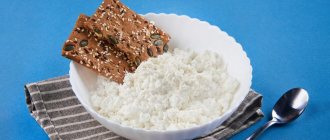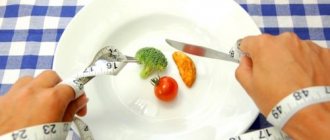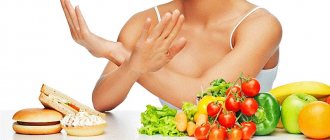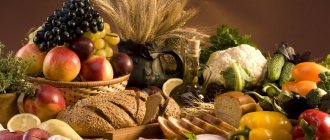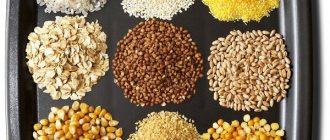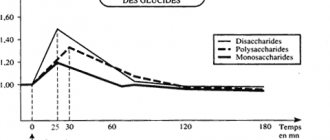Despite the widespread belief that fats are the root cause of extra pounds and related diseases, research in recent years has proven the opposite. Scientists are confident that moderate consumption of natural fats has a positive effect on the body and does not cause pathologies caused by excess weight. But there are synthetic trans fats that are directly linked to obesity.
- Percentage of fat in foods
Types and features
All fats that enter the human body with food are divided into two categories:
- Saturated ones are poorly absorbed and have a negative impact on health. Thus, regular consumption of food with saturated fats leads to the formation of blood clots in blood vessels and increases the risk of weight gain. In addition, to dissolve such elements, the stomach has to work hard and expend large amounts of energy. At the same time, excessive loads are placed on the body as a whole. But foods containing saturated fats should not be excluded from the diet - they are rich in vitamins. The main sources are pork, beef, lamb and other “representatives” of the diet.
- Unsaturated are fats whose distinctive feature is considered to be in liquid form. For this reason, they are absorbed easier and faster. The composition contains vitamins and elements that cleanse blood vessels.
It is worth noting that any fat leads to an increase in cholesterol. In turn, cholesterol can be bad (“clogs” the circulatory system) and good — on the contrary, it cleanses blood vessels. The peculiarity of unsaturated fats is that they reduce the level of bad cholesterol.
Unsaturated fats also come in two types:
- Monosaturated - accelerate the production of cholesterol that is beneficial for the body.
- Polysaturated - enriched with useful elements, one of which is Omega-3.
As a rule, polyunsaturated and monosaturated fats are always present in food at the same time. The only thing that changes is the proportion in which they are found in products. The main sources are nuts, seeds, vegetable oils.
Trans fats are substances that are separated into a separate type. What foods contain this type of fat? First of all, we are talking about food that undergoes special processing. The main sources are French fries, cookies, sausage, and so on. The downside of trans fats is the lack of benefits for the body and negative effects on health. Substances are obtained by processing vegetable oil, after which the latter passes into solid form. In addition, the manufacturer often replaces expensive fats with this product, which reduces production costs and extends the shelf life of the product.
Healthy fats: a list of foods worth paying attention to
Ideally, you should be getting both monounsaturated and polyunsaturated fats from your diet, focusing primarily on omega-3s. Until now, these two types of fats were considered healthy and suitable for daily consumption. Some foods on our list contain saturated fat, but it's better to stick to these foods than processed ones.
We recommend adding these high-fat foods to your diet. But you need to gradually introduce high-fat foods into your diet, starting two to three times a week. Also, if you increase your fat intake, then reduce your carbohydrate intake.
But now we will not go into such details. Just keep in mind: you shouldn't eat the pie if you've eaten a lot of fatty foods.
Dairy
- Yogurt
Yogurt will help improve digestion through the use of probiotics or live cultures and, according to research from the American National Library of Medicine, may also help with weight loss.
Thanks to the nutrients, yogurt energizes and provides a dose of calcium and protein.
Please be vigilant when purchasing yogurt: pay attention to labels to avoid products laden with sugar. It's better to dilute the yogurt yourself using what you like, such as honey, fresh blueberries and cinnamon.
- Cheese
Cheese is also an excellent source of protein, calcium and minerals, and may be most beneficial for appetite control.
Alana Aragona, a nutritionist and men's weight management coach, once said: “The combination of protein and fat in regular full-fat cheeses is very rich... As a result, snacking on full-fat cheeses keeps your appetite at bay for hours; I have found that this reduces the amount of food my clients consume in subsequent meals.”
Since this is still a very high-fat food, pay attention to portion sizes and adjust them as necessary.
Oils
- Olive oil
Although the next two products on the list were discussed above, they are still worth mentioning. Olive oil may contain more saturated fat than other oils, but its nutritional benefits greatly outweigh this disadvantage.
What does this product do useful?
As a result of research, it was found that olive oil contains many antioxidants. Olive oil can actually prevent the development of cancer cells and even cause their death. It also has powerful anti-inflammatory properties, thanks to a polyphenol called oleacansal. Oleacansal directly targets inflammation and pain like popular NSAID drugs, but without the side effects.
- Coconut oil
What can you say about coconut oil?
Coconut oil can improve cholesterol levels and provide a good boost of energy.
According to SFGate: “Coconut oil contains medium chain triglycerides, which are used directly by the body for energy.”
Who doesn't like an instant burst of energy?
Nuts and seeds
- Nuts
Nuts also provide a lot of energy, so it's good to always have them on hand. But the main problem with nuts is that they can contain extreme amounts of fat, so portion control is a must. Limit yourself to a handful because these guys get eaten too easily and unnoticed!
Let's take a look at this list of nuts and their fat content per 100 grams:
- Almonds: 49 g fat, 78% of calories come from fat
- Brazil nut: 66g fat, 89% of calories come from fat
- Cashews: 44 g fat, 67% of calories come from fat
- Hazelnuts: 61 g fat, 86% of calories come from fat
- Macadamia: 76 g fat, 93% of calories come from fat
- Pecans: 72 g fat, 93% of calories come from fat
- Pine nuts: 68 g fat, 87% of calories come from fat
- Pistachios: 44 g fat, 72% of calories come from fat
- Walnut: 65 g fat, 87% of calories come from fat
This list should not discourage you from eating nuts; on the contrary, it should prove that eating nuts in some quantities is a must.
- Seeds
Seeds can be considered like nuts: they are healthy and necessary, but only in small quantities.
Some of the best seeds:
- Chia seeds
- Flax seeds (ground)
- Pumpkin seeds (roasted, no salt)
- Sunflower seeds (roasted, no salt)
Despite their high fat content, chia seeds are very healthy. To be fair, flax seeds are also essential, plus they contain slightly less fat than chia seeds. Flax seeds are a source of fiber, antioxidants and essential omega-3 fatty acids.
By eating pumpkin seeds occasionally, you'll get antioxidants and about 50% of your recommended intake of magnesium. Mercola reports that magnesium is vital for the maintenance of bones, teeth, heart function, relaxation of blood vessels and promotes good digestion.
As for sunflower seeds, they are also rich in antioxidants, as well as fiber and amino acids. It's safe to say that these seeds should become a mandatory part of your diet.
- Nut butter
Its properties are similar to nuts. Nut butter is one of those foods that you shouldn't avoid. However, the right type of nut butter is necessary, just as if we were choosing nuts. I don't know about you, but my favorites are almond and nut butters.
Chop up a stalk of celery, add some almond butter, and sprinkle in some hemp seeds or chia seeds instead of the sugary raisins.
Vegetables
- Avocado
When it comes to very fatty foods, control is your best friend.
As you can see in the Guaranteed Nutrition Facts, an average serving of avocado should be about 1/3 of a medium avocado. Eating a whole avocado will provide you with 250 calories and 22.5 grams of fat. Of course, it's okay if you eat the whole avocado because it contains 71% monounsaturated fat, one of the best types of fat.
You'll find about 20 vitamins and minerals in an avocado, fiber, protein, omega-3s, 4 grams of total carbohydrates and about 1.2 grams of available carbohydrates, so an avocado is low in carbohydrates. All these benefits make avocado an essential high-fat food.
- Olives
Although olives are thought to be high in fat, they are high in monounsaturated fat, making olives an excellent addition to any diet.
As mentioned earlier, higher amounts of monounsaturated fats can be attributed to balancing blood sugar levels, lowering blood cholesterol, and reducing the risks of heart disease and stroke.
Animal products
- Eggs
Eggs have a fairly high cholesterol level, but the fat level is also high.
Most of the fat is in the yolk. That's why most people on low-fat diets eat only protein. The only problem is that all the fats found in the yolks are essential.
One large egg contained 1.6 grams of saturated fat, 0.7 grams of polyunsaturated fat, and 2 grams of monounsaturated fat. In addition to the healthy fats, you'll also get vitamins and minerals, thereby improving your metabolism.
- Steaks
Eating excess red meat can increase iron levels, thereby reducing the elasticity of blood vessels and increasing the risks of type 2 diabetes and Alzheimer's disease.
However, eating meat occasionally, such as two to three times a week, is good for your body
LiveStrong point out the need to buy the right cuts of meat. Some cuts may be higher in saturated fat and cholesterol, while others, such as tenderloin, contain more healthy fats in the right amounts. You can choose bison meat, it is leaner and healthier.
- Fish
Instead of purchasing expensive fish oil supplements, consider eating fatty fish such as salmon, sardines, trout or mackerel.
These types of fish contain high amounts of protein and essential omega-3 fatty acids.
According to the Harvard School of Public Health: “An analysis of 20 studies containing hundreds of thousands of participants found that consuming one or two three-ounce servings of oily fish per week—salmon, herring, mackerel, sprat, or sardines—reduced the risk of heart disease by 36 percent. "
Contents in products
When choosing foods rich in fats, it is worth considering their level. The main sources are vegetable oils and animal fats. As already mentioned, fats are suppliers of vitamins important for the body (tocopherol, retinol, B vitamins), as well as other substances. With their help, energy reserves are provided, the taste of food is improved, and a feeling of fullness is guaranteed. During the processing process, fats are formed with the help of proteins and carbohydrates, but they cannot be completely replaced.
In addition to fatty acids, the composition contains phosphatides and stearins. The main representative of stearins is cholesterol, which is most abundant in foods of animal origin. Let us repeat that its excessive intake leads to the formation of plaques in the body and the development of atherosclerosis.
What foods contain fats? Here it is worth highlighting several categories in terms of volume content:
- Volume - from 80% and more:
- sunflower and butter;
- pork lard;
- margarine;
- pastry cream.
- Volume - 20-40%. This category includes:
- cream;
sprats;
- sausage;
- pork;
- cheese;
- chocolate;
- halva.
- Volume - 10-19%. These fat-rich foods (listed below) are considered "moderate sources":
- mutton;
- beef;
- herring;
- sausages;
- chicken;
- eggs;
- processed cheese;
- ice cream.
- Volume - 3-9%. Products with low content include:
- mackerel;
- pink salmon;
- milk and dairy products;
- high fat kefir.
- Volume - until 3%. This category includes products that contain minimal amounts of fat:
- hake;
- beans;
- bread;
- cod;
- zander;
- pike;
- cottage cheese;
- milk (skimmed);
- beans.
It is also worth dividing foods according to the content of healthy and harmful fats for the body:
- Foods with saturated fats (including trans fats):
- margarine;
dairy products;
- fast food;
- fatty meat (after frying);
- chocolate;
- egg yolk;
- coconut and palm oil.
- Products containing unsaturated fats:
- fatty fish;
- nuts - peanuts, cashews;
- poultry (except skin);
- various types of vegetable oils - corn, flaxseed, olive and others;
- products from which oils are obtained - olives, peanuts, sunflower seeds.
Such fats should be supplied in small quantities. Otherwise, the risk of developing cardiovascular diseases increases. Also, an excess slows down metabolic processes and accelerates weight gain.
Foods high in fat
| Food product | Fats, g (per 100g of product), g |
| Butter, vegetable oil, margarine, lard | more than 80 |
| Nuts (peanuts, walnuts, almonds, hazelnuts, seeds) | from 40 to 80 |
| Cheese, full-fat sour cream (more than 20%), pork, duck, geese, eel, smoked sausage, rolls (especially with rich cream), chocolate, halva | from 20 to 40 |
| Full-fat cottage cheese (from 10%), cream, ice cream, lamb, beef, chicken (drumstick, ham), eggs, low-fat sausage, salmon, herring, mackerel, caviar, avocado (fruit) | from 10 to 19 |
Daily requirement
Having figured out which foods contain a lot of fat, it is worth learning an equally important nuance - the daily requirement for a person. On average, an adult needs 100-150 grams. At the same time, the amount of fat in the diet should not be lower than 30 percent (based on the BJU ratio). Calorie content is calculated taking into account the fact that there are nine kilocalories per gram of fat. Along with food, the body should receive (at the rate of 30%):
- 20% - unsaturated;
- 10% - saturated fats.
In the presence of heart disease, the dosage should be calculated individually.
For some people, the fat requirement is higher. They need to know which foods are rich in fats in order to better saturate their diet with them. This category includes:
- Pregnant and nursing mothers. At this time, energy is spent on the formation of the fetus.
- Representatives of professions associated with heavy physical labor. Here, the advantage of high fat content is quick saturation and a high number of calories.
- Wrong diet. If you are deficient in fat-soluble vitamins, your risk of health problems increases.
People should also know what fats contain and supplement their diet with such products if they lack energy, have decreased libido, or during the cold season. The last factor is easy to explain. In cold weather, the body is forced to spend more energy to warm up the body, so high-calorie foods help maintain heat for a long time.
There are situations when the need for fat decreases. It is worth highlighting here:
- Performing work in which greater emphasis is placed on mental work. In such a situation, it is recommended to lean on carbohydrate, but not fatty foods.
- Living in countries where hot climates prevail.
- Excessive body weight. People who are obese should limit their fat intake, but should not eliminate it from their diet.
It is worth remembering that the body copes with vegetable fats faster. This is easily explained by the special chemical bonds of products that are not resistant to the effects of gastric juice. Most often, vegetable fats are used to obtain large amounts of energy. As for animals, they provide a feeling of fullness due to slower digestion. In practice, women consume mostly plant-based fats. While male representatives prefer animal fats (which products contain them are discussed above).
How much fat can and should be consumed?
The World Health Organization recommends that healthy people consume 30% of their total dietary fat daily. In this case, you need to eat 10% saturated fat. Those who are at risk of developing cardiovascular diseases and diabetes - 7%.
However, Canadian scientists are calling for a review of these dietary recommendations. The results of their research showed that limiting total fat intake would not improve public health. It was found that if the amount of fats is 35% of the diet (half of them are EFAs), and carbohydrates are no more than 60%, then the risk of cardiovascular diseases and mortality will decrease.
Numerous studies have shown that high-quality, healthy saturated fats are not associated with cardiovascular disease. Their moderate consumption does not affect excess weight gain and the development of diseases. The exception is artificial trans fats, which have a direct link to obesity. Therefore, their consumption should be reduced or completely eliminated from the diet.
Deficiency and excess in nutrition
In order to correctly formulate a diet and promptly respond to health problems, it is worth knowing the signs of deficiency and lack of fat in the body. Understanding key processes is a chance to respond to changes in a timely manner and make adjustments to your diet.
Signs of excess include:
- increased blood clotting;
- development of atherosclerosis;
- activation of the process of formation of stones in the gall bladder and kidneys;
- destruction of kidney, liver and spleen cells;
- an increase in the number of plaques in blood vessels, increased stress on the heart, an increased risk of blocking blood vessels.
If you don't know which foods contain fats and don't include enough of them in your diet, the risk of deficiency increases. Its symptoms include:
- weakness and apathy due to lack of energy;
- disruption of the nervous system (exhaustion);
- inability of the body to absorb vitamins D and A;
- peripheral eye changes;
- distortion of the nail plates;
- deterioration in the appearance of skin and hair;
- problems with the reproductive system;
- weakening of the immune system and decreased resistance.
It is impossible not to note a number of factors that influence the rate of fat accumulation. Here, much depends on the presence of physical inactivity and lipid metabolism disorders associated with the development of atherosclerosis. It has been proven that residents of China, Japan and other countries where seafood and greens are eaten in large quantities do not suffer from such problems.
Another negative factor is stress, which also leads to the accumulation of excess weight. We must not forget about hormonal imbalances. Doctors often claim that metabolic disorders are directly related to an increase in estrogen.
How to calculate BJU for weight loss?
When starting to correct weight by optimizing the daily consumption of dietary supplements, it is necessary to make basic calculations that will allow you to achieve the desired result without harm to the body.
In what ways can daily calories be calculated :
Mifflin-San Geor method
For men: ((Weight×9.99 + Height×6.25) - Age×4.92+5)×K
For women: ((Weight×9.99 + Height×6.25) - Age×4.92-161)×K,
where K is the coefficient of physical activity:
- low physical activity - 1.2;
- insignificant - 1.4;
- average - 1.6;
- high - 1.7.
This formula may allow errors in determining the level of physical activity and distort the final result.
Example: a man and a woman, both 30 years old, work in an office and have low physical activity. The man’s weight is 90 kg, height is 182 cm, the woman’s measurements are 70 kg and 168 cm, respectively.
Per day they should consume:
((90×9.99+182×6.25)-30×4.92+5)×1.2=2272.8 kcal for men.
((70×9.99+168×6.25)-30×4.92-161)×1.2=1728.84 kcal for women.
Harris-Benedict method
For the calculation, indicators such as basal and active metabolism are used. Basal metabolism×active metabolism
For women: Basal metabolic rate = 447.593+(9.247×weight)+(3.098×height) - (4.330×age).
For men: Basal metabolic rate = 88.362+(13.397×weight)+(4.799×height) - (5.677×age).
Active metabolism:
- low physical activity - 1.2;
- moderate activity - 1.375;
- average activity - 1.55;
- intensive loads - 1.725;
- athletes - 1.9;
- building muscle mass - 1.2;
- weight loss - 0.8.
Example: a man and a woman with the same physical characteristics.
447.593+(9.247×70)+(3.098×168)-(4.330×30)×1.2=1782.53 kcal for women.
88.362+(13.397×90)+(4.799×182)-(5.677×30)×1.2=2396.64 kcal for men.
As you can see, the indicators differ slightly from those obtained using the previous calculation method.
You can calculate BJU for weight loss using the daily calorie intake, energy value and proportions of BJU. If for a woman we take the BJU ratio 5:1:2, and for a man 3:1:5, we get the following standards:
2396.64×0.3/4=179.75 g proteins;
2396.64×0.1/9=26.63 g fat;
A man should consume 2396.64×0.5/4=299.58 g of carbohydrates per day in order to build muscle mass.
1782.53×0.5/4=222.82 g proteins;
1782.53×0.1/9=19.81 g fat;
A woman should consume 1782.53×0.2/4=89.13 g of carbohydrates per day to lose weight.
The above calculations seem complex and cumbersome only at first glance. Having determined for yourself the most effective version of BZHU, over time you will be able to use it at the subconscious level, only occasionally checking the table of calorie content of foods.
Results
The diet should contain foods containing fats. It is recommended to keep the grocery list with you and plan your daily menu based on it. It is important not to abuse such food, to give the body only the necessary 100 grams of fat. At the same time, it is better that they belong to the category of unsaturated (beneficial for the body).
As for the trans fats mentioned in the article, it is recommended to avoid their consumption altogether. At first glance this is difficult. In fact, it is enough to give up junk food that is full of them and eat vegetables, fruits, nuts, meats and seafood.
How to lose weight on fatty foods?
We found out that without fats it is impossible to maintain health and beauty. When losing weight, it is important to follow several rules that were formulated by the famous nutritionist Jan Kwasniewski, then tasty fatty foods will only bring benefits.
- Maintaining the correct ratio. Per day you need to consume 2.5-3 parts of fats, 1 part of proteins and only 0.8 parts of carbohydrates. According to the nutritionist, it is this proportion that characterizes breast milk.
- There is no clear time for eating. You can eat as much as you want, the ban “after 18:00 - nothing but water” is lifted.
- It is important to observe the ritual of eating: in a calm environment, silently, without TV or newspaper. Food should be chewed well and not rushed.
- We refuse fruits, vegetables, and fiber from cereals. This is the complete opposite of traditional nutritionist recommendations. Fiber, according to Kwasniewski, is not digestible and does not bring benefits; vitamins and minerals can be obtained from meat and fish.
- Instead of plant foods, we eat animal foods: meat, fish, milk, cream, cheeses, eggs (up to 8 of them per day). The quantity of these products is practically unlimited (the main thing to remember is the BJU ratio).
The advantage of such a diet is the complete absence of hunger, emotional and energy uplift (a person does not experience stress associated with constant control and restriction). Exercise enhances the effectiveness of the method 2 hours after eating.
Sample menu
Breakfast: traditional omelet of 3-4 eggs. You can fry in butter or lard. We wash it down with unsweetened tea.
Lunch: 150 g of meat in any form (it can be stewed, fried, baked). Garnish: fried potatoes (2 pcs.), pickled cucumber.
Dinner: the nutritionist encourages you to skip dinner, but if your body doesn’t receive enough energy during the day, you shouldn’t starve it. We eat cottage cheese with sour cream (but without sugar), you can repeat the meat.
It is advisable to introduce this amount of fatty foods into the diet immediately, without preparatory steps. Having chronic diseases, it is better to get the approval of your doctor.
Contraindications
The diet has general restrictions associated with chronic diseases:
- cardiovascular pathology;
- chronic hepatitis, pancreatitis, other pathology of the gastrointestinal tract;
- oncology;
- endocrine diseases;
- kidney problems;
- elderly age;
- pregnancy;
- mental illness.
The diet is absolutely contraindicated for children and adolescents due to the possibility of metabolic disorders. Many nutritionists do not accept this system due to the complete lack of fruits and vegetables and the risk of high cholesterol levels. Their patients note the monotony of their diet.
Interesting Facts
- A diet enriched with fatty foods reduces the incidence of Alzheimer's and Parkinson's diseases.
- You can distinguish the structure of fats by their appearance: unsaturated - liquid, saturated - solid.
- A decrease in substances below the physiological norm leads to weight gain. The body turns on the stress response, and carbohydrates begin to be deposited in fat depots. For weight loss, it is important not to reduce the total amount in food, but to redistribute it towards useful fractions.
- Olive oil should not be used for frying. It completely loses its properties.
- Vegetables are better digested with vegetable fats, so salads dressed with olive oil are much healthier.
Fats are no longer the enemy of your figure. They are included in many weight loss systems and, when used correctly, bring benefits and beauty to the body.
Possible complications
A deficiency in the body's intake of essential fatty acids Omega-3 and Omega-9 leads to slow wound healing, arthritis, miscarriages, frequent constipation, and hair loss.
The main importance of unsaturated acids is the binding of oxygen and hemoglobin. If there is insufficient intake of these substances along with food, a person experiences a lack of strength, loss of vigor, insomnia, and decreased appetite.
An important function of Omega-3 is related to the reception and transmission of neural signals, so the absence of this fatty acid in the body causes rupture of the myelin sheath, the consequences of which include:
- hyperactivity and attention deficit in children;
- impaired motor response in adults;
- the appearance of multiple sclerosis;
- development of asthma and respiratory diseases;
- diabetes;
- visual impairment;
- strokes, heart failure attacks;
- development of Parkinson's and Alzheimer's diseases.
A lack of Omega-9 monounsaturated fatty acids leads to a decrease in immunity and the body's resistance to infectious diseases, and increases the likelihood of developing oncology. Insufficient intake of unsaturated fatty acids Omega-3 and Omega-6 into the body is often associated with their consumption in the wrong ratio.
When choosing food products rich in these substances, you must observe the proportions: 1:1, 1:2, 1:3 or 1:4, otherwise a lack of vegetable fats in the body will cause the following types of diseases:
- arthritis;
- migraine;
- tumors;
- obesity;
- infections.
Various complications can be caused by the development of diseases of the cardiovascular system, an increase in the risk of heart attack and stroke. Omega-3 and Omega-6 fatty acids are essential in the formation of fat-soluble vitamin F, which takes part in all biological processes.
Insufficient intake of these types of vegetable fats into the body causes cardiac arrhythmia, impairs blood circulation, and leads to the development of atherosclerosis. The list of dietary products should be compiled taking into account the body's need for polyunsaturated and monounsaturated acids.
Saturated fats of animal origin should make up 70%, and vegetable fats - 30% of the total amount of fat consumed. These substances, which enter the tissues after absorption in the human body, increase the energy reserves necessary for the normal course of physiological processes.
What to Look for on Food Labels
Before purchasing food products, carefully read the product ingredients on the packaging label. Look at the “nutrition value per 100 g” column to understand how much fat is contained in the product:
- High fat content = more than 17.5 g fat per 100 g
- Average fat content = 3.1 g - 17.5 g fat per 100 g
- Low fat = 3.0 g fat or less per 100 g
If the label indicates the amount of saturated fat, then the following indicators will be useful to determine the required amount:
- High saturated fat = more than 5g per 100g
- Average saturated fat content = 1.6 - 4.9 g per 100 g
- Low saturated fat = 1.5 g or less per 100 g
Nuts
Nut kernels are high in calories, but contain an abundance of healthy fats. The inclusion of a small amount of such a product allows you to obtain the necessary macro- and microelements, vitamins and comply with the BJU norm. Calorie content, fat content, recommended daily intake are indicated in the table.
| Calorie content | Healthy fats | Daily norm | |
| Peanut | 552 | 34 g | 32 g |
| Almond | 600 | 50 g | 20 g |
| Hazelnut | 650 | 60-70 g | 25-35 g |
| *Cashew | 640 | 8 g | 10-20 g |
| Cedar | 620 | 70 g | 1 tablespoon |
Cashews contain almost the same amount of “bad” fatty acids, so they are classified as conditionally healthy.
A low glycemic index (GI) of 15 means that nuts fill you up quickly. If you do not abuse the kernels, they will help you get rid of the habit of overeating.
Healthy fats in nuts
Combination rules
Saturated fats, the list of foods containing which includes meat and dairy products, must be properly combined with vegetable fats. The latter are polyunsaturated (Omega-3 and Omega-6) and monounsaturated (Omega-9). A healthy diet is only possible with the right combination of foods containing these substances.
This is necessary for the proper functioning of the digestive system, the features of which are as follows:
- absorption of nutrients based on certain enzymes;
- different rates of food processing by the stomach;
- production of gastric juice depending on the type of product;
- creating an alkaline environment for the processing of carbohydrates and an acidic environment for proteins.
Many types of seafood containing polyunsaturated fatty acids, as well as fish oil, can be digested by the stomach if it has an acidic environment. You need to be careful when combining them with starch-rich foods, since processing the latter requires an alkaline environment. Due to different digestion times, it is not recommended to mix fish with cereals, legumes, grains, and sour cream.
Nutritionists do not recommend eating nuts at the same time as meat or cheese. These foods contain different types of proteins that require the production of a specific type of digestive juice. They differ in their concentration and release time. As a result of consuming meat with nuts, heartburn occurs due to the excessive secretion of stomach acid.
Nuts, mustard, avocado, sesame, and olive oil contain Omega-9 fatty acid in large quantities. These foods are rich in vitamin F, which improves the functioning of the cardiovascular system. When consumed correctly, they normalize cholesterol and blood sugar levels and improve immunity. Nuts and sesame seeds can be combined with bananas.
It is better to consume olive or vegetable oil with vegetables, and drink milk separately from them or cook porridge with it. To replenish your body with vitamin C and relieve fatigue, you can sprinkle sesame seeds on a salad of red bell peppers and herbs. This vitamin, along with B3 and B6, is necessary for the body to absorb Omega-3 fatty acids. They are found in large quantities in seafood.
Legumes can be combined without restrictions with various types of foods. This feature depends on their starch content, which is compatible with vegetable fats. Pulses are often combined with starchy vegetables and leafy greens because they contain plant protein.
How do saturated fats differ from unsaturated fats?
The main difference lies in the chemical structure. Saturated (saturated) fatty acids consist of a single bond between carbon molecules. As for unsaturated fats, they are characterized by double or more double carbon bonds, due to which they are not subject to connection. Their activity allows them to pass through cell membranes without forming solid compounds.
Without delving into scientific terminology, you can note the difference in external characteristics by looking at them in their natural form - at normal temperatures, unsaturated fats have a liquid form, while the latter remain solid.
Saturated fats benefit the human reproductive system and are also important in the construction of cell membranes. In addition, with their help, there is a better absorption of certain vitamins and microelements. They are especially useful in cold weather because they are an excellent source of energy. The daily intake dose varies between 15-20 grams.
According to numerous studies, it has been found that a deficiency of fat can negatively affect brain function by changing brain tissue. Of course, this happens in very rare cases, but it does happen. If a person completely refuses to consume saturated fatty acids, then the body’s cells will begin to synthesize them from other foods, which will be an extra burden on the internal organs.
Chia seeds
Chia seeds and their healthy fats
Spanish sage is a miracle food containing monounsaturated fats and twice the omega-3 (polyunsaturated) acids of salmon. Chia seeds have no cholesterol.
The calorie content of the product is 486 kcal, but the daily intake does not exceed two tablespoons, which is equal to 86 calories. This amount is enough to get rid of hunger for several hours. This makes chia beneficial for those losing weight.
The effect of seeds on the male body was discovered by the Aztecs, who consumed them before hunting. They give strength and endurance. Being allergenic, they are not recommended for consumption by children and women during pregnancy and lactation.
Fat War: The Battlefield is Human
And now attention, the main secret: unsaturated fatty acids not only provide the body with “good” cholesterol, high-density lipoprotein (HDL), but also with its help constantly reduce the level of harmful LDL. That is, if you eat something containing saturated fats, it must also contain unsaturated fats, and then the “good” fat will win over the “bad” fat!
Many modern diets work on this effect - for example, the author of the “soup” diet, British nutritionist Fiona Kirk, testing her nutrition system, discovered that in order to lose weight, you do not need to avoid fat. It is enough to change your approach to its use: fat obtained from healthy sources helps to destroy even “petrified” fat deposits.
Research published in the American Journal of Clinical Nutrition confirmed that “high-quality” fatty acids speed up metabolism, with their participation food is digested better and absorbed fully. With constant dosed intake of the right fat, the body stops concentrating on creating its reserves. Scientists from the University of Washington School of Medicine clarify that dietary unsaturated fat activates a special protein called PPAR-alpha, which burns existing fat in the subcutaneous area of the abdomen, thighs, buttocks, and prevents the accumulation of fat in the liver.

